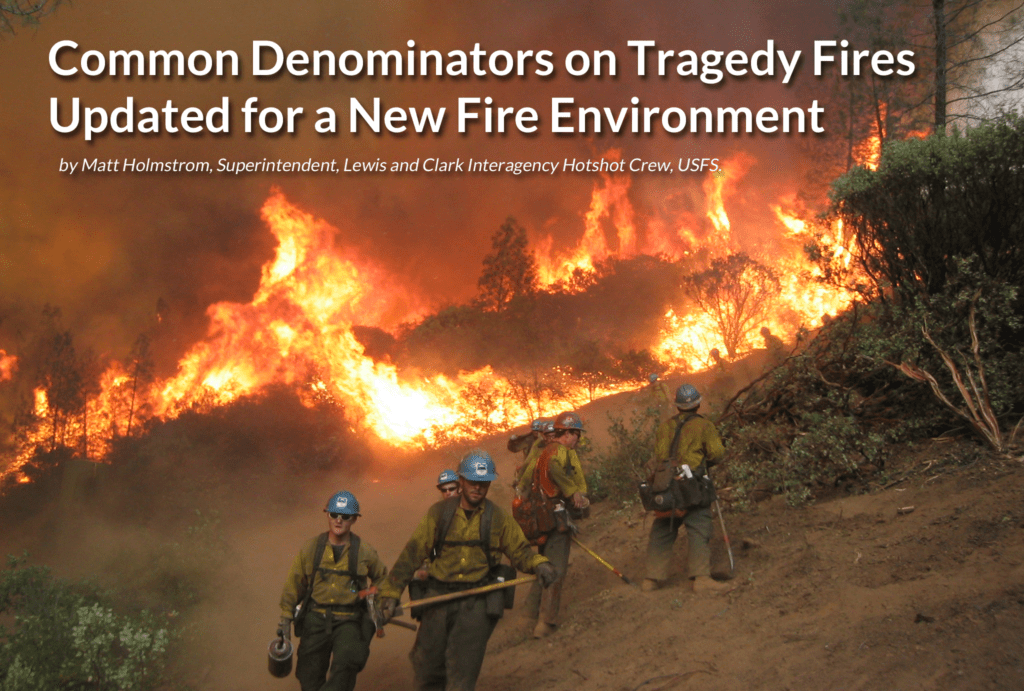
Article originally published by Wildfire Magazine in January 2016: http://wildfiremagazine.org/article/common-denominators-tragedy-fires-updated/
Common Denominators on Tragedy Fires – Updated for a New Fire Environment
by Matt Holmstrom, Superintendent, Lewis and Clark Interagency Hotshot Crew, USFS.
While for many years the standard “Common Denominators on Tragedy or Near Miss Fires” have inspired the study and hopefully the avoidance of the very common circumstances that have led to entrapments and deaths, I feel they are in need of an update. I hate to join the fray with additional checklists, factors, or items to remember, but I feel that the original list focused entirely on the fire environment, and ignored the human side of the equation. While I feel it necessary to discuss these ideas, I am most certainly not advocating a new checklist or concept to memorize.Carl Wilson, a fire researcher in the 1970’s built the first list:
The original common denominators (Carl Wilson)
There are four major common denominators of fire behavior on fatal and near-fatal fires. Such fires often occur:
1. On relatively small fires or deceptively quiet areas of large fires.
2. In relatively light fuels, such as grass, herbs, and light brush.
3. When there is an unexpected shift in wind direction or wind speed.
4. When fire responds to topographic conditions and runs uphill. Alignment of topography and wind during the burning period should always be considered a trigger point to re-evaluate strategy and tactics.
As you can see, the list is focused on the basics of fire – weather (specifically wind), fuels (fast moving), and topography (coupled with wind). The only item that seems to have anything to do with human behavior (specifically complacency) is the first, which mentions small fires or ‘deceptively quiet’ areas of a large fire.
In 2006 Dick Mangan took on this same topic after MTDC released a statistical analysis of fatalities. His list added to the original and I feel he made a very powerful case for his 21st century Common Denominators. His list is shown here:
Common Denominators for Wildland Firefighter Fatalities
As the major causes of firefighter fatalities shift, additional factors need to be considered:
5. Firefighters are most likely to die in an aircraft accident. Before every flight, fire managers must ask, “Is this flight essential?” and “Is everyone onboard essential to the mission?”
6. Firefighters are nearly as likely to die in a vehicle accident as in an aircraft accident. Driving too fast for the conditions, failure to wear seat belts, rushing to a fire, and driving home while exhausted from firefighting kills firefighters.
7. Firefighters can reduce their risk of dying from heart attacks on the job by staying fit, maintaining their body weight, and having regular medical checkups.
8. Unexpected events such as falling snags, rolling rocks, downed power lines, and lightning strikes cause more than 8 percent of fatalities during wildland firefighting operations. Firefighters and fire managers can reduce fatalities by learning to expect these unexpected events.
More than 20 percent of fatalities during wildland firefighting operations continue to occur in burnovers. Carl Wilson’s original common denominators are just as important in the 21st century as they were in the 20th.
While both Wilson and Magnan make outstanding arguments, I feel that they are only viewing half the problem. We know that we face unprecedented fire conditions, explosive fire growth, extremes in both weather and fuels, and increasingly complex interface situations. These are all very real issues, but they only address half the problem. The other half – the part we are only beginning to look at – is ourselves. The human behavior contributing to accidents is as important as the fire behavior. While we have begun to study this through concepts like High Reliabiilty Organizations and Risk Management, we have not translated those concepts into bite sized pieces that can be easily taught and communicated to firefighters on the line.
What I propose is simple: Take a few minutes to read and look over this paper. Discuss it with your co-workers and crews. Remember that you have the benefit of hindsight, and that these ideas seem very simple in the classroom or office. In a real world environment, under stress and time constraints, with thousands of inputs flooding your brain, what decisions would you make? It is not our place to judge, but rather to try and learn. It can be re-assuring or even comforting to believe that you couldn’t have made the same decisions, but we are all human, with all the wonders and failings of that human condition. Learn from the tragic outcomes of our fallen. While this should not become another list, or another page in the IRPG, it merits conversation and discussion. Take a look, discuss with your folks, poke holes in it, argue with me, with your crew. As long as it gets you talking and thinking, I would call that a success.
With all that in mind, here is my proposed Common Human Factors on Tragedy Fires, my arguments for their inclusion, and my examples from research.
1. Less than 2 years experience, 13-17 years experience.
These are the same numbers that we have all heard before. What is interesting is that there is data to support the idea, though it is not conclusive. The NFPA lists years of service at time of death, and those numbers (for 2003-2013) are here:
1- 5 years: 19%
6-10 years: 11%
11-15 years: 13%
16-20 years: 17%
21-25 years: 17%
Keep in mind these are rough numbers taken from all firefighters nationally, not just wildland, and for all causes as well. Additionally some research also shows that the mid-point of a career is most dangerous at least in regards to position qualifications. The research looked at the highest level of IQCS qualifications present at entrapment, meaning that when entrapments occur there was usually a single resource boss there. (Dotson –LL) Whether from more exposure, or a symptom of mid-career (13-17 years) is difficult to say, but I still find it telling. To me, this correlates with the concept of mid-career danger in that 54% of the entrapments over a 23 year long period occurred with a single resource boss being the highest position entrapped.
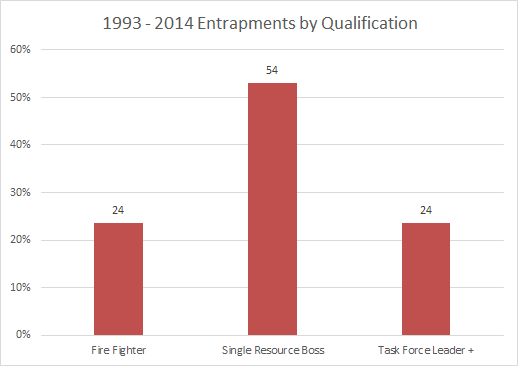
Less than 2 years makes some sense: the folks don’t know what they don’t know, and they are trusting their leadership and overhead to get them through. Their inexperience is understandable, and we need to do a better job of training and educating them, but most importantly empowering them. How do you react if your plan is challenged by a first or second year firefighter? If your plan cannot be explained to a GS4, how solid is the plan?
At 13-17 years, however, people have enough time in to think they’ve got good answers. This is similar in concept to pilots and their 200th flight hour – enough knowledge to be confident, but not enough experience to recognize new or unfamiliar hazards. Their Recognition Primed Decision-Making (often called “slides”) is not sufficient yet. Though it is full to the brim of options and decisions that look a lot like this new situation. When faced with a new decision on a compressed timeline, human brains try to make the best fit, and quickly. This can have tragic outcomes as our brains take short-cuts to decisions. The author of Killing Zone, Paul Craig, argues that 50-350 flight hours (with a notable peak around 200 hours) are the most hazardous time, with a significant fall-off in retention of important tasks and skills in that timeframe. As far as 13-17 years goes, I feel that complacency is often to blame. Folks in this group know the answers, often teach the courses – but they still have decision-making obstacles and challenges, as we all do. Complacency often grows as things become routine or normal. It is something that happens almost inevitably over time as time pressures, performance pressures, and risk normalization combine to trap us into taking on different risks. “I’ve been doing this for __+ years! No way that could happen to me!” This also adds up to complacent behavior towards the little things that also kill – health, transportation (ground and air), and gravity. I feel that after 17 years folks tend to move into other less exposed positions, or perhaps have more developed ‘slides’ in the Recognition Primed Decision making model.
Examples: Sadler, Thirty-Mile, South Canyon, Dude, Rattlesnake, Mann Gulch, Yarnell
2. Fire Entrapments occur between 1448-1642
This is the witching hour, to be sure. The 2014 WFSTAR report that spoke to these numbers is incredible. We all know how and when the fire will move across the landscape, yet in 19 of 26 separate burnover incidents we have fatalities that occur in this time period. One of the most striking things about this is the short average time from blow-up to entrapment. It was listed at 24 minutes. My recommendation? Be within 10-15 minutes of a true safety zone during that two hour period, at least for those Haines 6+ days where the fire is likely to explode. There is very little to be gained and too much to be lost in being overly aggressive for those hours on the most extreme days. While production would fall off a bit on those shifts, we would be much safer, and those shifts are likely unproductive anyway. This is not the time to be attempting to gain the initiative on a growing fire or for transitions, but instead to ensure everything is ready for what is about to come. This is when fire is strongest and we are weakest. In a guerrilla war (which we are definitely in) you don’t attack when your enemy is strongest, most organized, most poised to attack you. The excellent screenshot from the recent WFSTAR video dramatically illustrates this point. (WFSTAR: An Analysis of Burnovers.)
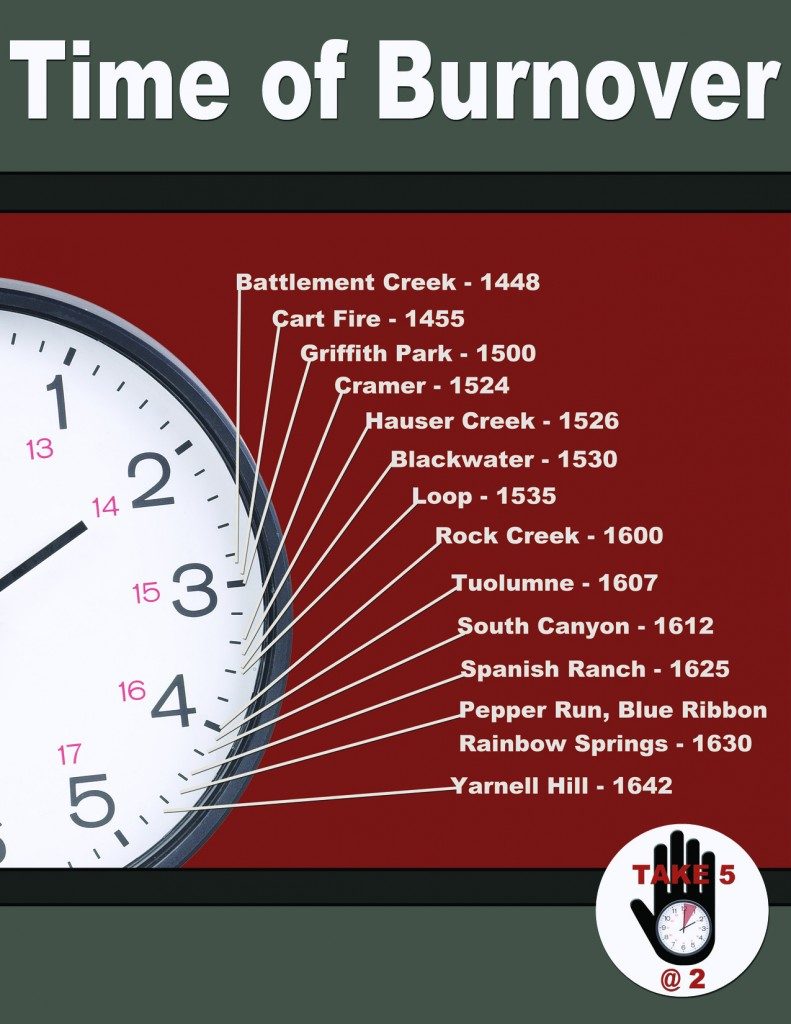
Time of Burnover. Source: http://www.nifc.gov/wfstar/library_firebehavior_weather.html.
While entrapments certainly happen during other times, the largest block of entrapments occurred during the heat of the day, peak burning time. Over 115 entrapments for a 21 year period more than half occurred in the 1400-1700 blocks of time. (T. Dotson, L.L.Center.)
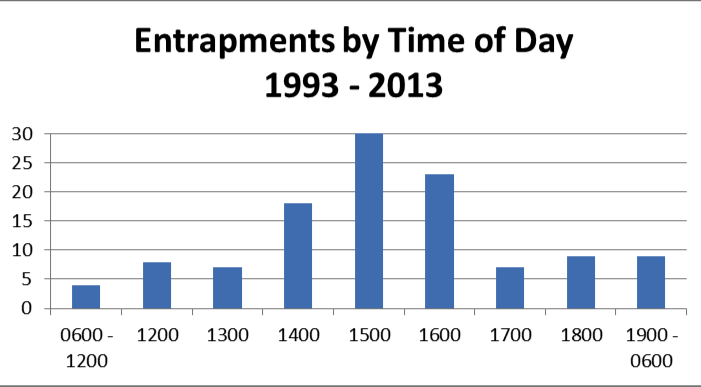
3. Wearing Too Many Hats/Poorly Defined Leadership
This one is very simple, and we have identified it repeatedly. There are methods in place to attempt to reduce this – ICS and command courses come to mind – yet we see it repeated. It is far too common in our profession to want to help, to want to take on roles we feel we can be valuable in. Unfortunately, this leads to all kinds of human factor conflicts, from Groupthink (where everyone agrees, or fails to argue) to competing priorities for our limited attention, to a Bias for Action (where “we’ve gotta do something!”). Everyone has a job to do on the fireline and that is enough. The human brain under stress is capable of remarkable feats, but also has remarkable shortcomings. It simply cannot retain all the inputs flooding it. Consider how it’s possible to remember a phone number but not what was on your last shopping list – and that is without fireline stress. In a chaotic, time-sensitive situation we all tend to go back to what we know, to the familiar and to the basis of our training. This leads to enormous gaps in leadership and decision making when wearing multiple hats: the person in a leadership position reverts to their most known and familiar, which all too often is not the position they are filling. An excellent example that shows up as a stress reaction occurs when the fireline leader or IC reverts to their prior training (because of stress) and instead of managing their incident begins to dig line or operate a nozzle.
Examples: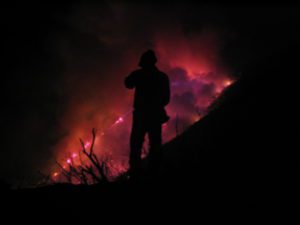
30 Mile – where the crew boss was also the IC trainee
Yarnell – where the superintendent was also the DIVS, the OSCs (field and planning) intermixed,
Panther – incoming team scouting fire to take over from T3 organization
South Canyon – emerging incident with IA IC and need to expand or re-organize
Rattlesnake – poorly defined command structure (In fairness it was ’53)
Cedar – Burn crew from another fire independently lights around structures
Tuolumne – emerging incident with IA IC and need to expand or re-organize
Dutch Creek – multiple folks in charge, from line into base camp
4. IA to Extended Attack Transitions
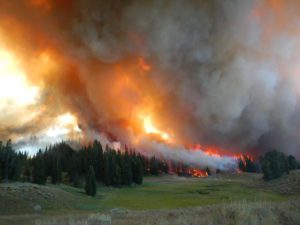 While both Initial Attack and Extended Attack are safe methods of controlling a fire, the transition period between them is extremely dangerous. Frequently people are attempting to implement a mix of these strategies in this transition period, as resources get briefed and fed out onto the line. All too many times people hang on to IA long after that strategy is defeated. Both direct and indirect attack methods are valuable tools in our bag, and both can occur during IA or extended attack. The problem occurs when because of a transition between IA to extended attack not everyone is using the same tool. The rapid escalation of fire growth plus an increased number of resources equals complexity and a need to shift to EA, perhaps the next level of leadership.
While both Initial Attack and Extended Attack are safe methods of controlling a fire, the transition period between them is extremely dangerous. Frequently people are attempting to implement a mix of these strategies in this transition period, as resources get briefed and fed out onto the line. All too many times people hang on to IA long after that strategy is defeated. Both direct and indirect attack methods are valuable tools in our bag, and both can occur during IA or extended attack. The problem occurs when because of a transition between IA to extended attack not everyone is using the same tool. The rapid escalation of fire growth plus an increased number of resources equals complexity and a need to shift to EA, perhaps the next level of leadership.
IA is fast-pace, reactive, and extended is slower, more purposeful and proactive. The difference between IA and EA for me is the difference between a 100 yard dash and a marathon; both are valid, both are races, but each has its own strategy and pace.
When we are stuck in a transition, often this is nothing more than a mindset problem, usually labeled as “target fixation.” Humans hate to lose, and firefighters hate it more than most. But in our 21st century fire environment, we will often lose fires. We just need to not lose firefighters. The problem is that this circumstance leads us to “loss aversion” where we have a tendency to “double -down” in an attempt to make up for losses that happened earlier. This is where we take extreme risk, risk we would never accept otherwise, because we are so far behind we feel we have to catch up. These are the risks that lead to short-cuts and failure to follow basic, sound firefighting principles. These are the risks that would never be taken if we were winning, if the fire was nearly controlled or in mop-up.
Examples:
30 Mile – IA had failed, but the tactics and plan called for the continuation of IA
Yarnell – IA was no longer realistic based on fire size and weather, but IA continued
Panther – Transition to extended attack was in progress
South Canyon – received in influx of people as it transitioned to extended with IA tactics
Rattlesnake – IA tactics only – chasing spots near an active flank
Tuolumne – small piece of direct (IA tactics) to tie in and begin the extended attack
Esperanza – Point protection on fast moving emerging incident moving to EA.
5. Earlier close calls or near misses
While we have all heard of the swiss-cheese model of accidents, I feel very few of us actually engage it on fire assignment. This was not the case at Yarnell in 2013, where folks mentioned the Swiss-Cheese Model and how many holes were appearing. Another firefighter responded that all they had were holes, and that they needed to build some cheese. Humans look for patterns and when we look back on accidents, we see a complete chain leading up to it.
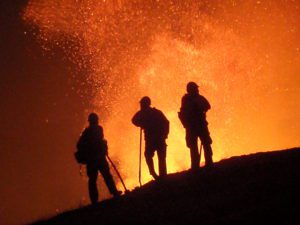
The challenge, then, is to identify these events in their infancy, when they begin – and interrupt them. On numerous fatality fires, there are precursors, moments when something happened that was wrong, felt wrong, or was a down-right near miss. Whether a fire that is unusually resistant to control, or a vehicle almost getting burned up, a strange set of burning conditions or a rapid change in the color of the smoke, afterwards people often remark on the strangeness of the day. We have intuitive knowledge that we routinely ignore, and at our peril.
As for myself, every near miss or fatality fire I have been on was preceded by a number of close calls. These are signs in our HRO that things are failing and that a major event is more likely, according to Weick and Sutcliffe. The close call can be completely unrelated to the accident – it is a symptom of a larger problem. When you see or experience a close call – slow down, analyze the situation. Are there issues with the organization or plan that contribute to the hazards you already face?
Listen to that lizard part of your brain, the part that makes your hair stand up, that makes you flinch. It’s been programmed, by you and your ancestors, to react to danger. Ignoring it is ignoring a powerful tool. Also empower your new folks, make them engage and ask questions. Their instincts are good too.
Examples:
Panther – crews had been pulled off the line due to increasing fire behavior multiple times
Bass River – crews had to take shelter in lake at time of blow-up
Golden Gates – multiple engines nearly burned earlier with wind shift
Cedar – engine crew was advised the structure was indefensible
Sadler – crews turned down assignment to burn, later accepted by others who deployed
Yarnell – multiple near misses throughout the day (buggies, aircraft conflicts, lookout)
Battlement Creek – aircraft crash day before entrapment
6. Conflict on the fireline
Human interaction is full of conflict and the fireline is a stressful place. Tempers flare, words get exchanged, and the result can be lost lives. I am not advocating an end to passionate debate or arguments, but when people cannot work together anymore an unsafe situation exists. Leaders need to have thick skin, to not be so married to their plan that it cannot be challenged. If your plan cannot bear the assault of some simple questions from one of your resources, either your plan is bad or you have too much ego invested in it. Either is bad in our business. When conflict sinks to the level of personal anger and hostility, we have fundamentally crippled LCES, by no longer communicating. We need to return to the basic concept taught in the L course series – focus on “What’s Right” not “Who’s right.”
Examples:
30 Mile – disagreement about hours on, rest needed and organization of the fire
Yarnell – conflict between divisions (which began previously) that led to one leaving the fire, conflict between AA and DIVs over burnout and retardant
Dude – disagreements and discomfort regarding the transitions between T2 and T1 teams
Dutch Creek – severe arguments about patient treatment led to a difficult hand-off
Cerro Grande – difficulty with dispatch, conflict over resource ordering pre-escape
7. Delivery of Firefighters – Return to Safety- Single Escape Route
When looking at fatality fires and near misses, we see a strong correlation between the options available for firefighters and the human factors that this creates. In an emergency situation, people go to what they know, to what they’ve been trained in. We fight fire the way we’ve been trained, and for years the E in LCES has been one of our weakest points, simply because we only ever seem to have one. “Slip and Capture” in Law Enforcement (where an officer grabs for a taser but pulls his gun) is a great example of trying to do one thing but in a high stress and time-compressed situation something else happens. For example, in a fire alarm or drill, people consistently run out of a building by the same manner they entered, even if danger is present there. We flee to what we know, our fear of the unknown is simply that strong, and our instincts and brain create tunnel-vision. All too often this results in the error of attempting to get back to the LZ, the ship, or the helispot. In other cases it is not the aerial delivery but the attempt to return to safety, to the known, the the safe place where the shift began. All too often, the escape route is back down the line to the trucks. When we only identify a single escape route, our planning lacks resilience and depth. Any problem with that single escape route forces you into a narrow decision-wedge. Any failure in that escape threatens lives. We need many options for escape routes, especially when we take a look at the numbers for safety zone size. (Butler- MTDC)
Examples – Aerial:
South Canyon – helitack crewmembers were on the ridge and continued to run uphill
Mann Gulch – crew attempted to run up-hill and back to their jump-spot
Cramer – Helitack waited at the LZ for a ride that never came
Examples – Return to Safety:
30 Mile – crews attempt to go back to their route of travel, find it blocked and slowly deploy
Yarnell – crew attempts to return to the ranch – a “bomb-proof SZ”
Dude – initially run down to escape, find route blocked, attempt to return to earlier work area
8. Communication failures, Miscommunication, or No Communication
As this is such a critical part of the safety culture that we have developed, it seems redundant and unnecessary to mention it here. Unfortunately, it is not only a common denominator, I feel it is the common denominator. It appears on nearly every tragedy incident. We have cemented this failure into place. These are not issues with radios, repeaters or cell phones. All too often, folks misunderstand, fail to brief or communicate with each other, or more simply do not talk. I challenge you to research a fatality and not find a communication error or lapse. I simply cannot. From assuming that people understood the plan, heard the weather, or got briefed, to more dramatic failures to brief, to coordinate, to listen and understand – communication gaps are our most common killer.
Examples:
Panther – early no communication (attempting to scout fire without radio frequencies, miscommunication on location)
South Canyon – no relay of weather hazard (cold front) from dispatch to fire command
Rattlesnake – confusing directions during emergency phase
Cramer – timelines and hazards unclear, response time to pick up request unclear
Nutall – 2-3 crews attempting to use the same “safety zone” where one crew deployed
Sadler – misstating experience level and ability, poor timing of burn, unclear intent
Battlement Creek – no coordination between different crews leads to one burning underneath another
Loop – radios largely unused, no communication with fire crew at bottom anchor
Esperanza – miscommunication about assignment and crew location
Cedar – independent burn crew, indefensible structure
Grand Prix – chaotic evacuations, WUI intermix lead to miscommunication between resources
The time has come for us to look at the other half of accidents; It is no longer possible to focus on the event and not the people. Human behavior and fire behavior both need to be understood if we are to prevent deaths in the future. With that said, it is critical to remember that we are looking back and attempting to learn from events in our past as any HRO should. But we have the benefit of hindsight – perfect clarity and a laser focus on the chain of events that led to tragedy. None of us can or should judge others’ actions. The outcomes, however awful, were never intentional. As Dr. Sidney Dekker wrote,‘You have to assume that nobody comes to work to do a bad job… people were doing reasonable things given the complexities, dilemmas, trade-offs and uncertainty that surrounded them.’ To be a true HRO/Learning Culture we need to acknowledge that mistakes are not failures; that we are all susceptible to errors and stress, and that the only fault to find is if we fail to learn from our fallen. As I mentioned earlier, this is not intended to create more rules or another checklist – merely to get us all talking and debating after we lost 36 firefighters [in 2013] in yet another heart-breaking season.
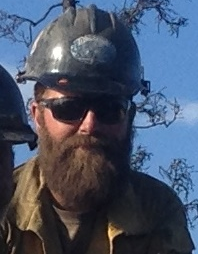
Matt Holmstrom is the Superintendent, Lewis and Clark Interagency Hotshot Crew, USFS
References and Works Cited
Braun, Curt C. and Latapie, Buck HUMAN DECISIONMAKING IN THE FIRE ENVIRONMENT
Fire Management Notes Volume 55·No.3·1995
Cowen, E.L. (1952). The influence of varying degrees of psychosocial stress on problem-solving rigidity. Journal of Abnormal and Social Psychology. 47: 512519
The Field Guide to Understanding Human Behavior – Sidney Dekker Ashgate Publishing, Burlington Vermont, 2006
Munson, Steve and Dick Mangan, Wildland Firefighter Entrapments 1976 to 1999, 0051-2853-MTDC, 5100 Fire, October 2000
Hockey, G.R.. (1986). Changes in Operator Efficiency as a Function of Environmental Stress, Fatigue, and Circadian Rhythms. In: Boff, K.R.; Kaufman, L.; Thomas, J.P. eds. Handbook of Perception And Human Performance (vol.II). NewYork: Wiley
Fireline Handbook – PMS #410-1
Incident Response Pocket Guide – PMS #461
Fahy, Rita; LeBlanc, Paul; Molis, Joseph. FIREFIGHTER FATALITIES IN THE UNITED STATES-2013 National Fire Protection Association Fire Analysis and Research Division June 2014
Killing Zone: How and Why Pilots Die Dr. Paul Craig McGraw-Hill Professional; 2 edition January 2013
Young Men and Fire – Norman MacLean University of Chicago Press, Chicago 1992
Thinking, Fast and Slow. – Daniel Kahneman Farrar, Straus and Giroux, New York 2011
Managing the Unexpected – Resilient Performance in an Age of Uncertainty – Karl Weick and Kathleen Sutcliffe. Josey-Bass Publishers, 2007
The Thirty –Mile Fire – A Chronicle of Bravery and Betrayal – John MacLean. Henry Holt and Company LLC. New York, NY 2007
The Esperanza Fire: Arson, Murder, and the Agony of Engine 57 – John MacLean. Counterpoint Pub. 2013
Fire and Ashes – On the Front Lines Battling Wildfires – John MacLean. Henry Holt and Company LLC. New York, NY 2004
Deep Survival- Who Lives, Who Dies and Why – Laurence Gonzales. WW Norton and Company New York, NY 2003
WFSTAR – 2014 Annual Refresher Training – An Analysis of Burnovers
John Allendorf
December 4, 2017
Well done! Thank you jw